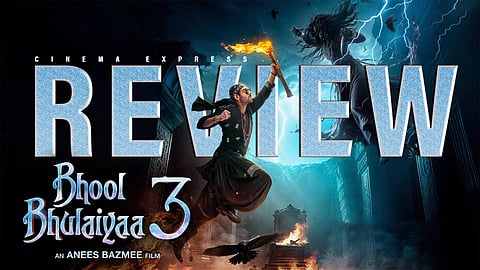Bhool Bhulaiyaa 3 Movie Review: Kartik Aaryan’s film is a lesson on how not to make a horror-comedy
Bhool Bhulaiyaa 3(1.5 / 5)
When Bhool Bhulaiyaa released back in 2007, things were simpler. There was no pretense of making a horror-comedy which would revive an industry from a ‘content slump’; no visual effects to supposedly amp up the dullness in the writing nor the delusion of working with ‘trendy’ faces to bring in ‘big numbers’. When Akshay Kumar starred in the horror-comedy in the role of a pragmatic and flamboyant psychiatrist, it was the irony of his appearance and actions that induced genuine laughter. When he made an entry mid-way through the film wearing hippy clothes, it felt absurdly organic. It was the time of Priyadarshan who made his films not as mere showpieces but as a means to reciprocate emotions – through a blend of the heartfelt and the comic. Anees Bazmee marched through the same era, as he made the unusually funny, Welcome (2007) in the same year which was filled with memorably cackling moments. Cut to 2024, Welcome has become a meme phenomenon; Priyadarshan has been away from Hindi films for a while and Bazmee has taken to directing the sequels of Bhool Bhulaiyaa with Kartik Aaryan as the protagonist. The result, however, is laden with major inconsistencies.
It is astounding how unimaginably flat and painfully loud Bhool Bhulaiyaa 3 comes out to be. Taking some of the elements of the 2007 film, combined with certain ideas from Bhool Bhulaiyaa 2, it presents an overtly familiar ‘ghost’ story with some random jests and unfocused scenes. Like the first part, there’s Manjulika, the infamous classical dancer of the yesteryears who vows to take revenge and is caged behind a closed door of a massive haveli. Like the second part, Manjulika has a sister, with whom she shares a conflicted relationship. Ruhaan aka Rooh Baba has found his ‘calling’ this time. As a self-proclaimed ghost-hunter, he tricks people by creating fake supernatural scenarios. Until one day, when his fakery is caught by Mira (Triptii Dimri) and her ‘Mamaji’ (the inimitable Rajesh Sharma). They blackmail him into agreeing to come with them to Rakhtghat, a village in Bengal, in order to help their family get back their ancestral mansion where Manjulika is locked. Ruhaan is apparently the reincarnation of a prince who was murdered by the witch 200 years before and it is ‘written’ that he will eventually destroy her.
Starring: Kartik Aaryan, Triptii Dimri, Vidya Balan, Madhuri Dixit, Vijay Raaz, Rajpal Yadav, Sanjay Mishra and Ashwini Kalsekar
Director: Anees Bazmee
Bazmee’s definition of horror and comedy is simplistic. It is not as inventive as the tactics of the Stree films. Rather, it works in seclusion. Scenes of cliched jump-scary terror are immediately followed by superficial moments of unsavoury comic-relief. Horror is confused for shock, which it solely invokes by VFX and heightened background music.
The writing is woefully bland, especially in the comic scenes which Bazmee is known for in films like No Entry (2005) and Singh Is Kinng (2008), among others. The desperation to be funny leads to some strange decisions. Like, inserting the song ‘Sandese Aate Hain’ from Border (1997) in the background of a scene where characters are seen returning to the mansion after staying away from it for years. Or resorting to common Bengali phrases, ‘Na Korbe’, ‘Khub Bhalo’, ‘Aamar, Tomar’ when nothing else seems to be working. There is also a scene where Triptii casually sings the Rabindrasangeet, ‘Chini Go Chini’ from Charulata (1964), a tribute which both Tagore and Ray won’t be too proud of. However, more is yet to come. I was left in complete disbelief in the final act when Shah Rukh Khan’s intro scene from Jawan started playing along with the theme music. I looked around. Is this an ad? Am I dreaming? Sadly, not.
Among its many shortcomings, the one that stings the most is how the film underutilised its versatile cast. The combined energy of Rajpal Yadav, Sanjay Mishra and Ashwini Kalsekar is reduced to unnecessary one-liners. Vijay Raaz as the descendant of a royal family is utterly out of place as he wears his costume and tries to find the lost beat of a scene. The striking presence of Vidya Balan in the original film is replaced by a flavourless appeal here. There is little for her to do apart from barely invoking the memory of her remarkable performance in the 2007 film. Madhuri Dixit has an awkward presence too, apart from some relief in getting to see her dance on the big screen after long, in a song that’s patchily filmed without much grace. As a result, it is just Kartik who is given the most attention. It is difficult not to be reminded of Akshay’s mannerisms and dialogue delivery in Kartik’s own performance, which seems heavily inspired without much of an original touch. He merely reacts to situations with enhanced theatrics that doesn’t go with the film’s tone which is confused whether to go all out and become slapstick or just stay within the realms of subtlety. Triptii seems to be carrying a similar appeal of her recent two releases this year, Bad Newz and Vicky Vidya Ka Woh Wala Video. Her enigmatic portrayal of a Bengali woman in the 2020 horror film Bulbbul begins to feel distant and surreal. Like the film itself, Triptii too is a product of desperate times, where the need to create a blockbuster surpasses the true aim of cinema: to engage and evoke.
Bazmee’s second rendering of the original film seems to have lost out on its soul. The pleasure and ultimate resolution of Bhool Bhulaiyaa lay in its debunking of superstition with a touch of science by finally reiterating the dangerous effect that childhood traumas can have on a person’s mind. That the true ghost resides in the head. It’s completely lost here without any such undercurrent and while it's fine for it to be just a genre piece, yet, the many references to the original end up defeating the purpose. It stops being an extension and becomes a parody of sorts. Here, there are spirits, salvation, black magic and rituals. The sublime vanishes, farcical takes over.


